As employers strive to provide workers with adequate PPE to protect themselves from exposure to COVID-19, OSHA has issued interim enforcement guidance on decontamination of filtering facepiece respirators (FFRs).
themselves from exposure to COVID-19, OSHA has issued interim enforcement guidance on decontamination of filtering facepiece respirators (FFRs).
The memorandum offers compliance safety and health officers guidance on enforcing OSHA’s respiratory protection standard, 29 CFR 1910.134, with regard to reusing FFRs that have been decontaminated through certain methods.
The guidance notes that in environments where respiratory protection must be used, and acceptable alternatives are not available for use in accordance with OSHA’s previous COVID-19 enforcement memoranda, NIOSH has identified limited available research that suggests the following methods offer the most promise for decontaminating FFRs:
- Vaporous hydrogen peroxide
- Ultraviolet germicidal irradiation
- Moist heat (e.g., using water heated in an oven)
If these methods are not available, the NIOSH-evaluated research shows that the following methods could also be suitable options for decontamination:
- Microwave-generated steam
- Liquid hydrogen peroxide
According to NIOSH, employers should not use the following methods unless objective data become available to sufficiently demonstrate that these methods are safety and effective:
- Autoclaving
- Dry heat
- Isopropyl alcohol
- Soap
- Dry microwave irradiation
- Chlorine bleach
- Disinfectant wipes, regardless of impregnation (i.e., chemical saturation)
- Ethylene oxide
NIOSH also states that only respirator manufacturers can reliably provide guidance on how to decontaminate their specific models of FFRs. If manufacturers’ recommendations are not available, third parties may provide guidance or procedures for decontaminating respirators without impacting respirator performance.
Employers are encouraged to explore the methods identified with specific FFR models and with manufacturers or third-party input and support to better understand the impact of different methods on respirator performance, filtration, fit and structural integrity.
Furthermore, employers should be able to demonstrate the effectiveness of decontamination against likely contaminants of concern and ensure that decontamination methods do not produce additional safety hazards. If additional hazards are created, employers should ensure that workers are adequately protected through appropriate engineering and administrative controls, safe work practices and PPE.
OSHA says it will continue to consider methods for FFR decontamination on a case-by-case basis as objective data demonstrating the safety and effectiveness of such methods become available, and provide updated guidance, as appropriate.
This guidance will remain in effect until further notice.
Related Links
OSHA to Consider Good-Faith Efforts for Compliance During COVID-19 Pandemic
Three Keys to Addressing COVID-19 in the Workplace
OSHA Interim Enforcement Response Plan for COVID-19 Pandemic
OSHA Temporarily Suspends Some Recordkeeping Requirements on Work-Relatedness of COVID-19
10 Ways to Reduce Worker Exposure to COVID-19